Welcome to La Miccia! This newsletter is too long to fit in your inbox. Head over to the website or click on “view in browser” to catch the full version. Thanks for reading!
I spent the week sharing a workspace with PhD students, which was a welcome change of scenery from my usual WFH setup. It also meant that I had zero distractions - have you ever been surrounded by academics on a deadline? Your girl was in the zone. So, this week’s newsletter is a long one - grab a seat.
In today’s letter:
The story of Italy’s porn star turned politician
Thoughts on authenticity and the value of copies vs. originals
Why unpaid internships suck
The latest on the repatriation of the Benin Bronzes
GETTING FREAKY ON A BOULDER
The news of a lawsuit against Jeff Koons being dismissed sent me down a rabbit hole, let me break it down for you. Jeff Koons is an American artist known for his weird-as-shit, but not weird in a good way, art. In 1990 he unveiled his Made in Heaven series, which features sexually explicit photographs involving him and his ex-wife, Ilona Staller (also known as Cicciolina). Staller is the quintessential multi-hyphenate: a porn actress, singer, and politician. She and Koons were married for a few years in the early 90’s.
Fast-forward to 2021 - 30 years after Made in Heaven - when set designer Michael Hayden filed a lawsuit claiming the series violated copyright laws by featuring one of his sculptures as a prop in the backdrop of Staller’s adult performances. In fact, back in 1988, Hayden had created a 6.5ft sculpture of a serpent wrapped around the pedestal of a boulder for one of Cicciolina’s adult performances as part of her production company Diva Futura. The lawsuit was dismissed this week on the grounds that it was time-barred, as Hayden failed to pursue legal action in a timely manner, but his legal team plans to appeal.
The most fascinating part of this whole story, to me, is Diva Futura, which is said to have marked the golden age of the porn industry in Italy (not hard to believe, considering Staller was out there commissioning massive snake statues). The production company didn’t just release porn films, it also had a line of calendars, erotic hotline subscriptions, and live shows that sometimes featured live animals - some performances were outright banned for being too explicit.
Diva Futura was also politically engaged. Staller, alongside her co-star and collaborator Moana Pozzi, founded the Partito dell'Amore (Party of Love), a political movement that advocated for sexual freedom and the decriminalization of sex work. Cicciolina herself was elected to the Italian Parliament in 1987 under the Radical Party, making her the world’s first porn star to hold public office. The production company’s eponymous movie came out just last year - has anyone seen it?
While we’re on the topic, it turns out Christians aren’t too fond of paintings depicting priests and nuns performing fellatio. Artist Fabián Cháirez’s exhibition La venida del Señor (The Coming of the Lord), featuring nine paintings of clerical men and women in sexual and subversive poses, faced criticism from conservative figures and Catholic protesters. After all, Christianity is on the rise.
People protesting art would have had heart a attack if they lived in Pompeii when Dionysian mystery cults were going on. Archeologists have just discovered a new series of rare frescoes depicting initiation rites for followers of Dionysus (reports suggest they includeed excessive consumption of wine, animal sacrifices, ecstatic dancing, and orgies to achieve spiritual transcendence).
The Great Wall of China is 300 years older than we thought. I feel like we often forget how insane the Great Wall is - over 13,000 miles long (21,196 km), its construction spanned over multiple dynasties and 2,000 years, and was carried out by over 1 million workers. It’s also the perfect breakup spot, if you ask Marina Abramović and Ulay.


The arts sector’s use of unpaid interns for some roles could be illegal in the UK. This article from The Guardian is brilliant because it boils down the problem: you need to be rich to afford working for free. Because only people from certain backgrounds can afford to take unpaid internships, the arts and culture sector is disproportionately overrepresent by the upper classes. I’m glad we’re finally talking about this. I remember when I was in the UK, having just graduated with my Master’s in Heritage Studies. I wanted to get a job in the arts sector, only to quickly realize that I couldn’t afford an unpaid internship. If an internship is unpaid, it automatically becomes accessible only to a certain group of people.
The Guggenheim just laid off 20 of it’s employees. In the meantime, current and former Brooklyn Museum workers have been protesting the institution’s staff cuts.
Does it matter if a painting believed to be an original actually isn’t? A painting on display at the National Gallery once attributed to Peter Paul Rubens is now thought to be a 20th-century copy. The news comes 45 years after the artwork was purchased and installed. There’s a lot to unpack here, but I’m always curious about what it means for something to be authentic.
This is not the first time I ask myself this and many of these questions came up in the article below, after discussing the 2018 piece Wearing, Gillian by artist Gillian Wearing.
In her piece, Wearing uses AI technology to deepfake her own face onto others and makes the point that if she hadn’t told us she was using deepfakes, we wouldn’t have been able to tell. This is similar to the National Gallery Rubens situation - if this article hadn’t come out to tell us that the painting on display is a copy, we wouldn’t have known. We would have walked into the museum, looked at the painting, and felt like we were seeing a Peter Paul Rubens. We would have probably walked away thinking, wow that was a really beautiful Rubens.
Even though Wearing, Gillian and the Rubens copy are different, the same question applies: If an experience feels authentic to the person engaging with it, can we truly claim it isn’t? In that same essay, I make a distinction between authenticity and historical accuracy. The latter can be defined as an artefact that is original to its time period and not a replica or facsimile. In the case of Rubens, could we say that the work isn’t historically accurate but still provides an authentic experience? It’s worth questioning whether the emotional impact of art is tied more to the object itself or to what it represents to the viewer.
Elizabeth Street Garden filed a federal lawsuit against New York City to protect the garden under the Visual Artists Rights Act of 1990. I am waiting for the sun to come out so I can go read there.
The British Museum and the Science Museum in London continue to have BP as a corporate sponsor, despite the oil company’s recent decision to move away from its climate targets. They are the only two museums in the UK that still receive sponsorship money from fossil fuel companies.
Grimes has a newly found optimism for art’s faith, thanks to AI-generated art…
… but this shit was AI-generated. So really, what is there to be optimistic about?
Italian Arte Povera pioneer, Michelangelo Pistoletto, has been nominated for the 2025 Nobel Peace Prize. Pistoletto, in a statement commenting his nomination, said that art should be “promoting peace as a self-certified expression of intelligence” which made me pause for a second and think about what that means. I think he’s referring to art as serving as a direct, authentic way of conveying ideas that foster peace but also that art should prove its value on its own, without needing anyone else to say it’s important. And as one of the major exponents of Arte Povera, that would make sense, as the art movement was born out of a rejection of art’s elitist values. His work is currently on view in NYC at Levy Gorvy Dayan until March 29th.
Just last week, I was talking about ownership, and now Nigeria has announced that the National Commission for Museums and Monuments will be in responsible for housing the Benin Bronzes once repatriated - a change from the 2023 presidential decree that named the Oba (King) of Benin as their rightful custodian. The change reportedly stems from the Benin Royal Court’s lacks of infrastructure to properly house the bronzes.
The 2023 decree had stalled many museum returns, as repatriating the bronzes to the Oba rather than a national institution required more complex agreements and negotiations between the Nigerian government, the Oba, and foreign institutions.
Cambridge University promised to return its collection of Bronzes over three years ago, but negotiations were halted. Excited to see what will happen now.
A collective of artists is offering free home portraits for those affected by the LA wildfires. Heartwarming.
Manhattan’s New Museum is set to reopen this Autumn following a major expansion and the Leonardo da Vinci Museum of North America is set to open in Pueblo, Colorado, later this year.













